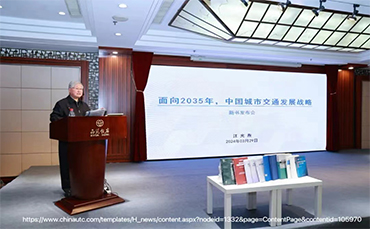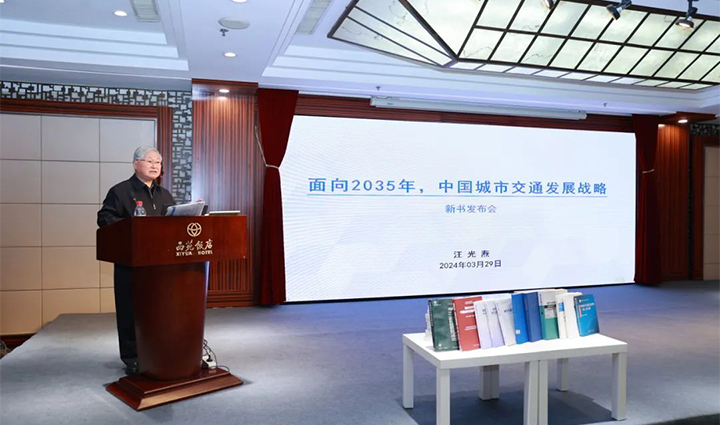



Image source: https://www.chinautc.com/templates/H_news/content.aspx?nodeid=1332&page=ContentPage&contentid=105970
On March 29th, the National Natural Science Foundation of China held a conference in Beijing to present the key findings of its major projects and to launch the new publication 'China Urban Transportation Development Strategy Towards 2035'. Authored collectively by experts and scholars in the field of urban transportation, the book grounds the foundational public service supply system and operational mechanisms for urban transportation through the framework of 'Four Goals, Three Directions, and Ten Actions', thus providing clear guidance for future urban transportation development.
At the press conference, Wang Guangtao represented the team to introduce the achievements of the new book. He emphasized the significance of urban transportation studies as an integral part of urban science, as the essence of urban transportation lies in levelling-up the foundational urban public services. Urban transportation secures the urban residents’ essential and equal mobility needs for commute and leisure daily. With the government-led, market entities participated development scheme, the sustainable operation of cities is guaranteed.
The book proposes the foundational public service supply system and operational mechanisms for urban transportation through the framework of 'Four Goals, Three Directions, and Ten Actions:
The Four Goals include the adherence to problem-oriented and goal-oriented development, the resolution of current transport issues with a strategic perspective, the guidance of urban governments’ leading role in regeneration and new development, the enhancement of residents' sense of belonging and general wellbeing, thereby improving the capacity of sustainable development and competitiveness of cities.
The Three Directions are: Enhancement of the level of basic life service to meet residents' fundamental needs; Support and service provision for the implementation of national strategies; Increase in the foundational public service capability of cities.
The Ten Actions are: Quality upgrade of '15-Minute Living Circle' services; Improvement of commuting efficiency; Enhancement of delivery service capabilities primarily for daily necessities; Establishment and improvement of collaborative governance mechanisms; Regulation of ownership and usage of motor vehicles and electric bicycles; Prioritization of urban public transportation development; Collaboration between super and mega-cities and surrounding areas in constructing metropolitan transportation systems; Acceleration of the green and low-carbon transformation of urban transportation; Enhancement of the service functions of urban transportation networks with new infrastructure; Innovation in urban transportation planning concepts and transformation of planning methods; Application of new technology and personnel training."
During the roundtable discussions, constructive viewpoints and suggestions are shared by professionals and scholars.
Regarding the issue of parking, it is agreed that sufficient, efficient automobile parking is the 'golden key' to unlock current issues of urban transportation governance, as the misuse of limited public parking space is raising concerns. Legalization, formalization, marketization, and digitalization are four keywords to address better parking infrastructure. The new book proposes the importance of using parking governance as a lever to regulate the ownership and usage of motor vehicles, advocating for the establishment of a parking facility property registration system, improvement of relevant parking governance regulations, establishment of a market-driven pricing mechanism for parking fees, and promotion of the industrialization and smart development of parking.
For promoting urban green transformation, the book proposes to promote the shift from intensive use of automobiles to sustainable modes of transportation. It emphasizes the need to address infrastructure and public service deficiencies during urban renewal processes, thus improving the quality of cycling and walking services to encourage both active modes of transportation. The concept of the '15-Minute Living Circle' represents the most common area for residents' daily mobility needs, so the configuration of transport facilities based on people’s average walking radius remains crucial. The non-motorized transport modes are the insurance of a convenient living style, which enhances community vitality and activity at the same time.
With the decline of overall passenger volume, insufficient coordination among transportation modes, inadequate infrastructure service capacity, and low service quality, China is facing challenges in terms of sustainable urban transportation development. The new book aims at raising awareness for urban public transportation as the essential pathway towards urban resilience and quality living. Through the exploration of new organizational models including Mobility as a Service (MaaS), research in diversified pricing mechanisms for high-capacity transportation services, and utilizing fiscal funds effectively to support the participation of various market entities, the overall service level of urban public transportation is expected to be leveraged together with general enhancement of financial sustainability.
The conference was guided by the National Natural Science Foundation of China, organized by the China Urban Transportation Development Forum Organizing Committee, and jointly hosted by Tongji University, Beijing Transport Development Research Institute, China Academy of Urban Planning and Design, and Shenzhen Urban Transport Planning and Design Research Center Co., Ltd.
Source: <https://www.planning.org.cn/news/view?id=15361>
Translated by Xiong Yuxi